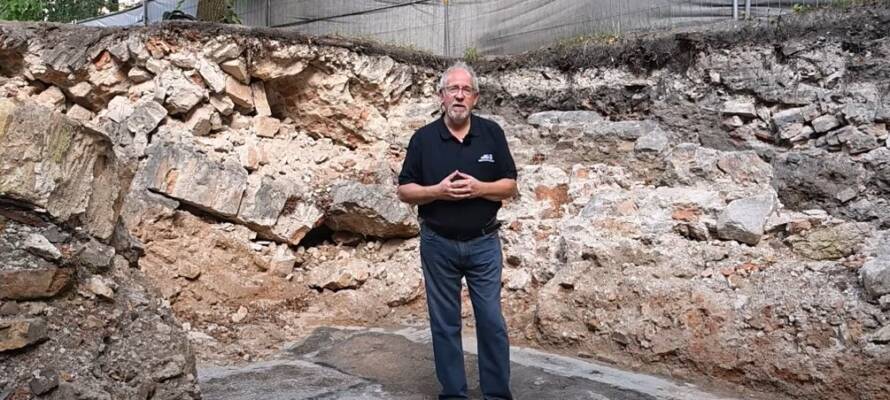The large and magnificent synagogue of Vilna, built in the 17th century in the Renaissance-Baroque style, was the oldest and most significant building of Lithuanian Jewry.
By World Israel News
New discoveries have been revealed over the past few days in the archaeological excavations exposing the remains of the Great Synagogue of Vilna (now Vilnius in Lithuania) from the 17th and 18th centuries, destroyed in and after the Holocaust.
As part of the fifth season of excavations, new sections of the floor of the Great Synagogue were uncovered for the first time, showing them to be decorated with red, black and white flowers.
Also discovered were part of the women’s section of the synagogue (Ezrat Nashim) and huge water reservoirs that were used to feed halachically pure water to the mikva’ot used by the community.
The excavation also exposed one of the iconic giant pillars that surrounded the Bimah (prayer platform) of the synagogue, now collapsed on its side – testimony to the intensity of the deliberate destruction the site after 300 years of continuous activity.
In the excavations – on behalf of the Israel Antiquities Authority, the Association of Lithuanian Archeology, the Good Will Foundation and the Jewish Community of Lithuania, it also turned out that the walls of the synagogue were decorated, the excavation showing the remains of a section of wall, painted with blue and red motifs.
The large and magnificent synagogue of Vilna, built in the 17th century in the Renaissance-Baroque style, was the oldest and most significant building of Lithuanian Jewry, until it was destroyed during and after the Holocaust.
In its heyday, the synagogue was surrounded by a complex of other synagogues, mikvahs and community institutions that formed a large center of Torah study and community life – the beating heart of the Lithuanian Jewry, which included 12 synagogues and study houses, the community council building, the home of Rabbi Eliyahu – the Vilna Gaon, kosher meat stalls, the famous ‘Strashun’ library, a bathhouse and more.
The place, sacred to the Jews of Lithuania, was looted and burned by the Nazi Germans, and later its remains were completely destroyed by the Soviet authorities, and a modern school was built there.
During the 2015 season of work, the results of a ground-penetrating radar survey showed significant remains of the synagogue below the surface, and since then, there have been 5 excavation seasons at the site, revealing the complex’s rich past.
According to the Excavation Directors, Dr. Jon Seligman from the Israel Antiquities Authority and Justinas Rakas from the Lithuanian Archeological Society, “The magnificent remains we are discovering – the synagogue Bimah that was uncovered during the previous excavation seasons – as well as the colorful decorations of the floor and walls – bring back moments in the life of a lost vibrant community.”
“The architectural wealth and vitality we encounter – alongside the destruction of impressive giant columns that collapsed during the destruction of the synagogue by the Nazis and the Soviets, tell the tragic story of a community that lived here, that is no more.”
According to Eli Escusido, Director of the Israel Antiquities Authority, “this important excavation has been going on in Lithuania for a number of years, led by a team of archaeologists from the Israel Antiquities Authority and Lithuanians, takes on a new importance this year, after October 7.”
“In the face of rising anti-Semitism and attempts to deceive and deny, there is one undeniable truth, both simple and tragic, which tells us about an entire magnificent community that was destroyed due to hatred of Jews – Never Again.”
